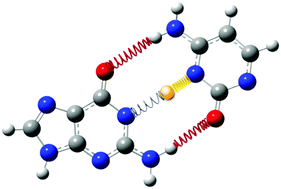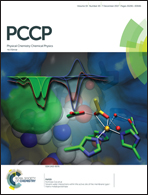A direct dynamics study of the deprotonated guanine·cytosine base pair: intra-base pair proton transfer, thermal dissociation vs. collision-induced dissociation, and comparison with experiment†
Abstract
Direct dynamics trajectories were calculated at the B3LYP/6-31G* level of theory to examine the intra-base pair proton transfer and dissociation of the deprotonated guanine (G)·cytosine (C) base pair under different excitation conditions, and to explore the origin of the nonstatistical product branching reported in a collision-induced dissociation (CID) experiment (Phys. Chem. Chem. Phys. 2016, 18, 32222). Trajectories for thermal excitation were initiated at two major conformers G·[C–H]− (hydrogen-bonded guanine and N1-deprotonated cytosine) and G·[C–H]−_PT (formed by proton transfer from the N1 of guanine to the N3 of deprotonated cytosine), and at their transition state (TS). Thermal excitation was realized by sampling molecular vibrational levels and TS's reaction coordinate energy with Boltzmann distributions at temperatures of 960 and 1330 K, which correspond to classical energies of 3.0 and 5.0 eV, respectively. Thermally excited trajectories undergo intra-base pair proton transfer extensively. The resulting conformation scrambling leads to nearly equal branching between the dissociation channels of [G–H]− + C and G + [C–H]−. Collisions of G·[C–H]− and G·[C–H]−_PT with Ar were each simulated at collision energies of 3.0 and 5.0 eV, respectively. The probability for intra-base pair proton transfer decreases substantially in collision trajectories. The CID product branching calculated on the basis of the population-weighted trajectory results of G·[C–H]− and G·[C–H]−_PT reveals a strong preference for [G–H]− + C, consistent with the experiment. Trajectory analysis corroborates that nonstatistical CID is attributed to inadequate conformation interconversion during collisional activation, and to the faster dissociation of the G·[C–H]−_PT conformer albeit G·[C–H]−_PT has nearly the same translational-to-vibrational energy transfer as G·[C–H]−.



 Please wait while we load your content...
Please wait while we load your content...